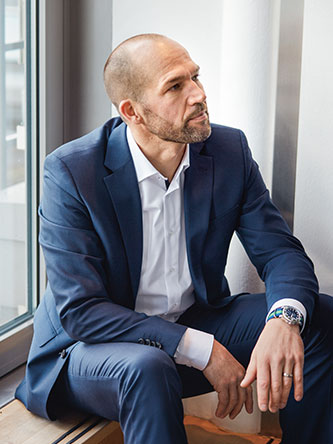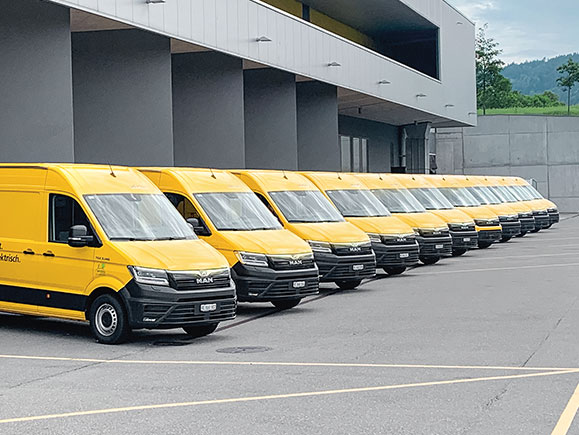Electrifying vehicle fleets means changing the rules of the game. Do routes or schedules need to be adjusted? When, where, and with what energy supply will the vehicles be recharged? The electrification experts from MAN Transport Solutions don’t leave fleet operators to answer these questions unaided. Using detailed analysis, they create deployment and charging plans tailored to the use case in question.
The end of one trip is the start to another. And most of the time with a quick turnaround—whether it’s a public transportation bus or a delivery vehicle for last-mile delivery in a city. The driver has only just stepped out of the vehicle and it’s already taken to be cleaned, visually inspected, and have its mechanical status briefly checked: is maintenance or servicing work due? Not least, the vehicle is refueled. At many depots, refueling is straightforward because there is a service station on site. Even if the trip ends as the day finishes, and there are only a few hours between the end of one working day and the start of another, it doesn’t take long, and the vehicle is ready to go again for the next shift.

Stefan Sahlmann: developing individualized deployment plans based on detailed analyses.
“In day-to-day operations, transportation companies have lots of vehicle parameters to consider. Electrifying fleets means changing the rules of the game.”Stefan Sahlmann
Head of MAN Transport Solutions
Example: project flow of a bus fleet in public transportation
Network analysis and deployment concept
The current state of operations and fleet deployment is analyzed. Taking all influencing factors into account, a tailored deployment concept is developed for a cost-effective transition to buses with alternative drive technologies.
Deployment planning and charging infrastructure
Based on the deployment concept for alternatively powered vehicles, a suitable charging strategy and charging infrastructure concept are planned. Additionally, an optimal energy supply strategy is developed for vehicle operation.
Fleet integration and maintenance
Advice on deployment and maintenance of the entire bus fleet, support with training employees, and qualified partners for service workshops.
Concepts and solutions for fleet electrification
When fleet operators decide to transition some of their fleet to electric vehicles, processes like these change. “In day-to-day operations, transportation companies have lots of vehicle parameters to consider,” says Stefan Sahlmann. “Electrifying fleets means changing the rules of the game.” To support this change, MAN introduced a service offering called MAN Transport Solutions. For two and a half years, a team of half a dozen experts headed by Stefan Sahlmann has been working on concepts and solutions for fleet electrification. In developing these solutions, MAN consultants especially consider their customers’ unique operational situations, which can be very specific. For local public transportation companies, this currently means solutions for the deployment of the electric MAN Lion’s City E bus; for parcel delivery companies—solutions for the MAN eTGE electric van, and soon also the MAN eTruck. “Our advisory service brings us closer to our customers,” says Sahlmann. “That makes sense for the simple reason that we are the ones who know the electric vehicles best. We no longer want to just sell vehicles to our customers; we also want to provide optimal support to them as they plan deployments, and with that, their introduction to electric mobility.”
And that is by no means a trivial task. MAN experts first analyze the route network, schedules, and the timeline and roadmap for the specific operational situation. They then take a close look at the specific utilization and loading conditions of the vehicles. Other important parameters include environmental factors such as topographical conditions of the roads traveled and the climate. “In terms of energy consumption, there is a big difference between a van navigating the lowlands of the Netherlands in the springtime and tackling a mountain road in Switzerland in the winter,” explains Sahlmann.
Once all the data has been analyzed, the MAN Transport Solutions consultants develop a deployment plan for the electric vehicles. How much electrical energy is needed, and where, and when? Will the vehicles be recharged at the depot only, or is this also necessary while driving on public roads? What charging capacity is required, and what is the estimated charging duration? Data analysis carried out by MAN Transport Solutions provides the answers to these questions. For example, if a day trip can be done within the electric vehicle’s range—even in the worst possible conditions en route—then there is no need to charge it on the road. “Swapping a diesel-engine vehicle for an electric-drive vehicle is possible on some routes without any changes,” explains Sahlmann. “But for other routes, time for recharging must be built into the schedule, or the deployment of additional vehicles arranged. Sometimes it also helps to optimize the route navigation for the deployment of electric vehicles.”
A holistic approach
In addition to being involved when planning deployments directly, MAN experts, in collaboration with their customers, develop training concepts for maintenance and service employees to familiarize them with the specific requirements for electric vehicles. Often, the question of where the electrical energy can be sourced also has an important role to play. This is because most of the time, the rationale behind deploying electric vehicles is making transportation operations carbon-neutral one day—and that is only possible with energy from renewable sources. For example, some of the electricity can be generated in-house in many cases, say from a solar system on the roof of the operator’s facility or depot.
Over the past few years, MAN Transport Solutions has already implemented more than 60 projects across Europe, including in Sweden, Germany, France, Spain, and Poland. In Switzerland, MAN consultants are currently supporting the deployment of 11 MAN eTGE electric vans with a 36 kWh battery. In June 2019, they were delivered to Swiss Post and have since been deployed in Ostermundigen, a neighboring town of Bern; in Geneva; and in St. Gallen, on Lake Constance. “By 2020, Swiss Post aims to reduce its CO2 emissions by 25% compared with the 2010 level. The state-owned company intends to become completely carbon-neutral by 2050,” explains Sahlmann. “Our project began with an electrification feasibility study, and since then, we have developed a multi-phase model for complete fleet electrification based on a location analysis.” Over the coming four years, Swiss Post aims to deploy up to 400 electric vans for parcel delivery. “We are already realizing that electric vehicles can be deployed in a lot more use cases than originally thought,” says Sahlmann. “Our first instinct is often assuming the highest requirements for features such as range. Upon closer inspection, however, we realize that this is not even necessary in many cases.”

In Switzerland, MAN consultants are currently supporting the deployment of 11 MAN eTGE electric vans.
“Our project began with an electrification feasibility study, and since then, we have developed a multi-phase model for complete fleet electrification based on a location analysis.”Stefan Sahlmann
Head of MAN Transport Solutions
MAN experts are currently planning the deployment of an electric bus with the Verkehrsbetriebe Hamburg-Holstein public transportation company (VHH) in Germany. From the end of 2019, they plan to send a 12-meter-long MAN Lion’s City E with 37 seats, a 480 kWh battery pack installed on the roof, and 150 kW charging capacity on a trial run in Hamburg’s suburb of Bergedorf. The bus will be charged at the depot—however, this also requires planning. That is because the Lion’s City E will not be riding solo for long: the VHH has already ordered another 17 vehicles for delivery by the end of 2020. The MAN advisory team is ready: “Unlike in private transportation, commercial vehicle fleet processes are usually easy to plan,” says Sahlmann. “And that’s where the greatest opportunity lies.”



.jpg/jcr:content/Teaser-Grafik-Tiva-Sharifi-3840x2560-V1-(1).jpg
)
.jpg/jcr:content/Teaser-Grafik-Mansoureh-3840x2560-V1-(1).jpg
)



